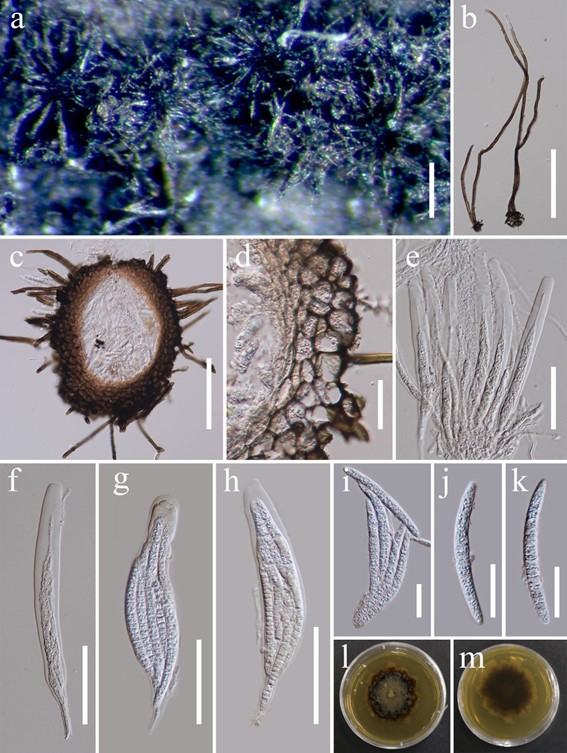Tubeufia longiseta D.Q. Dai & K.D. Hyde, Fungal Diversity 82: 42 (2016).
Index Fungorum: IF 552029; Facesoffungi number: FoF 01985; Fig. 84
Saprobic on dead culms of bamboo in a forest. Sexual morph: Ascomata 230–350 μm high × 170–220 μm diam. superficial, gregarious, ellipsoidal, subglobose, setose, coriaceous, with a central ostiole, dark brown to black. Ostiole single, central. Setae 320–410 × 3.5–4.5 μm, dense, flexuous, covering the whole ascoma, unbranched, rounded at apical end, septate, dark brown. Peridium 25–45 μm wide, composed cells of textura angularis, dark, with innermost part comprising thin layers of hyaline to pale brown cells of textura subprismatica. Hamathecium comprising numerous filiform, septate, branched, cellular pseudoparaphyses. Asci 130–160 × 13–18 μm ( x̄ = 150 × 15 μm, n = 20), 8-spored, bitunicate, cylindrical, rounded at apex, with an ocular chamber, thick-walled, short-pedicellate. Ascospores 55–75 × 4.5–6 μm ( x̄ = 65 × 5.3 μm, n = 50), 2–3-seriate, broad fusiform, cylindrical to long subfusiform, elongate, slightly curved, tapering towards rounded ends, hyaline, 13–17-septate, guttulate. Asexual morph: undetermined.
Culture characteristics: Ascospores germinating on water agar and germ tubes produced from ascospores within 12 hours. Colonies growing on PDA, circular, with flat surface, edge undulate, reaching 11 mm in two weeks at 28 °C, brown to dark brown. Mycelium superficial and partially immersed, branched, septate, hyaline to pale brown, smooth.
Material examined: Thailand, Chiang Rai, Mae Fah Luang University, on dead culms of bamboo, 19 February 2017, Yong-Zhong Lu, MFU01 (MFLU 17-1119, HKAS 100789); living culture, MFLUCC 17-1810.
GenBank numbers: ITS: MW136949, TEF1: MW147764, RPB2:MW147765.
Notes: Morphologically, our new collection resembles Tubeufia longiseta in ascomata, asci, and ascospores (Dai et al. 2017). Although the ascospores of our new collection are longer than the holotype of T. longiseta (55–75 vs. 38.5–55.5 μm), we identify them as the same species as there is only a single base pair difference in the ITS sequence data. We provide LSU, rpb-2 and tef1-α sequence data in this study, but we could not compare them to the holotype of T. longiseta as it has only ITS sequence data available (Dai et al. 2017).

Fig. 84 Tubeufia longiseta (MFLU 17-1119). a Superficial asco- mata on substrate. Note ascomata surrounded by black setae. b Setae. c Ascoma. d Peridium. e–h Asci. i–k Ascospores. l, m Colonies on PDA from above and below. Scale bars: a, d, i–k = 200 µm, b, c = 100 µm, e–h = 50 µm
Species
